It’s almost time for the next monthly 16mm Cartoon Carnival program, and what better way to preface it than to wish Betty Boop a very happy 90th birthday right this moment? In August of 1930, Betty debuted in a decidedly more poodle-like form in the Fleischer Studio’s Talkartoons short Dizzy Dishes. Early animator Grim Natwick was responsible for this initial design and the animation. While Poodle Betty may be unsettling or amusing to anyone who’s solely familiar with the far more recognizable Betty forms of about 1932-1936, and especially her more contemporary designs and outfits in modern merchandising of the past 40+ years, it’s also difficult for me to believe that Betty has become a nonagenarian…and will be a centenarian. Shudder!
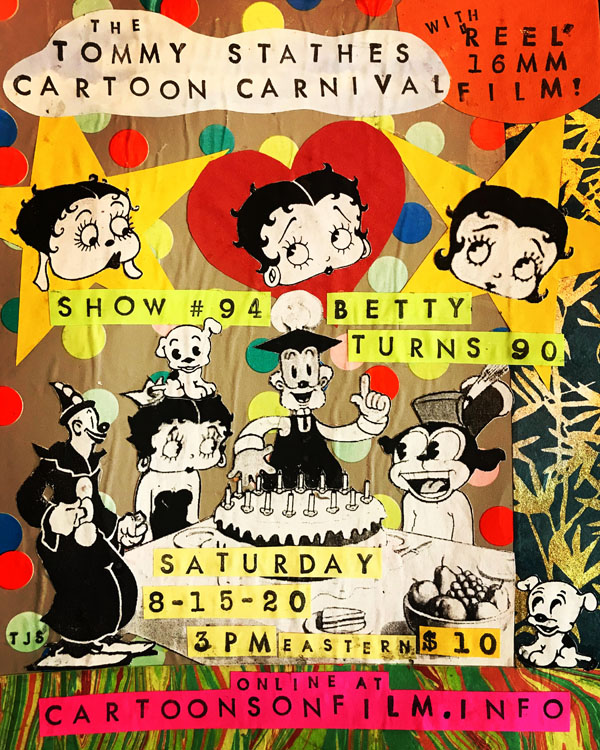
As a friend recently exclaimed, “Betty looks pretty good for 90.” I’m not going to think too hard about that, lest we get into ageist discourses. Anyway, here she is in her debut short…featuring Natwick’s fun, fluid, and loose designs:
We’ll be watching it together, in vintage 16mm form, in just a few days. Cartoon Carnival 94: Betty Turns 90 will take place this coming Saturday, August 15th, at 3pm eastern time (12 noon on the west coast). Gotta catch it in real time if you would like to watch!
This program will offer a smattering of all periods of classic 1930s Betty: her salacious early adventures with sidekicks Bimbo and Koko the Clown; appearances with famous 1930s musicians in live action and rotoscoped form; and fun times with Betty’s later cast: the inventive Grampy, her nephew Junior, and Betty’s beloved little dog Pudgy. There’s even going to be a selection of goodies that I bet most or all of you readers haven’t seen before—including one entire cartoon short, and some other archival footage and video material that all relates to the creation and propagation of the character.
Be prepared for a Cartoon Carnival that is longer than usual…with more cartoons than we normally show, and all of these extras, I estimate the entire stream will last roughly 4 hours, and we’ll probably need two intermissions instead of one!
You can take part regardless of geographic location. Visit the new Online Cartoon Carnival page for more information and even some of our past streams as new Video On Demand viewing options. The ticket purchasing/stream viewing link for Saturday’s upcoming show is here. Make sure you’re on our mailing list here if you would like to receive regular updates about these shows.
Stathes Collection.
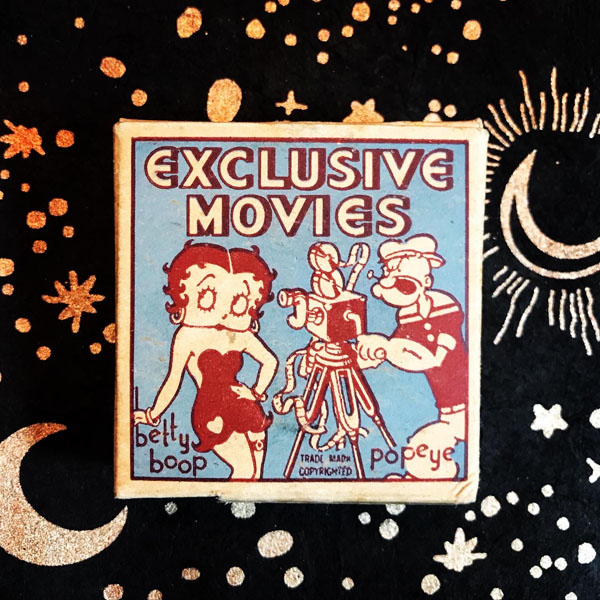
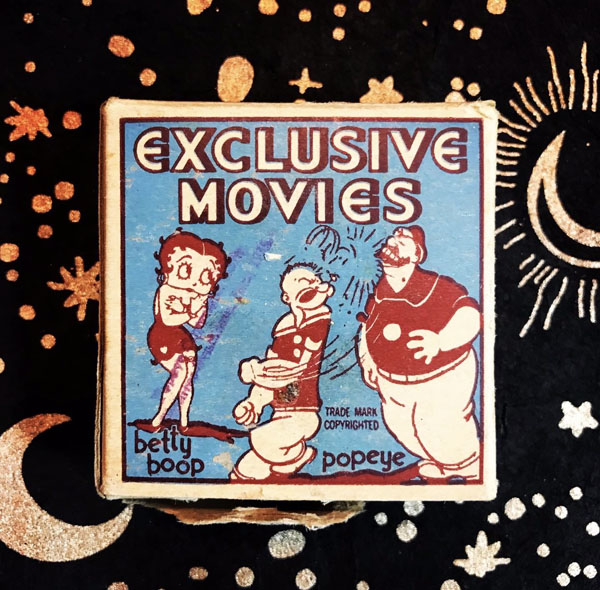
Here’s one early Betty that I won’t be showing, if only because the sound quality of my 16mm print is very poor. Crazy Town (1932) has been a favorite of mine since early childhood, when I first saw it as part of a couple PD cartoon VHS tapes—most notably Rhino Video’s Johnny Legend presents Weird Cartoons. This is a weird one, alright…and lots of fun in a beautifully surreal way that New York City contemporary Van Beuren Productions might have tried emulating at times, but couldn’t really pull off as well as the Fleischer team could:
And, completely out of left field here for a moment: who can forget this commercial at the end of Rhino Video’s tapes? I do miss the 1990s world of home video, VHS tapes, and browsing physical catalogs.
Back to this print of Crazy Town: I’ve long been intrigued by that 1960s or 1970s-era fake intro title, then and especially now, as the distribution history of these shorts and the way in which they’ve been mangled and butchered over the decades has always been fascinating to me. These manipulations are often a sore spot for serious fans and historians, especially archivists, and yet I like to reiterate that these films were created as commodities and have been continuously treated as such over the decades, going through many periods where their historical significance was not understood or valued in a way that makes sense to the Cartoon Research crowd. It’s all a part of the story, and all important to some extent in my book.
On that note, many of the Betty Boop cartoons were also subject to (or, as some might say, victimized by) redrawing and colorization in the 1970s. Out of fairness to the distribution history of the character, I’ll also be showing one example in my 16mm program, no matter what anyone thinks! In many ways, these films are bastardizations, true—but if enough ego is turned off, I like to sit back and think of these as amusingly kitschy, ‘shabby chic,’ psychedelic trips in their own way. Here’s Crazy Town in its redrawn colorized version, which I hadn’t even seen before writing this post and gathering some videos for illustration.
Beyond opening a discussion here for our love of Betty and sharing the news of this retrospective, I won’t go much further into specific history of the character or some of the controversies concerning the character, the Fleischer studio, or even contemporary research of the studio. It’s a ‘territory’ that’s almost as rough-and-tumble as the old New York City from which the cartoons originated; with certain illusory gates kept by only the most appropriately-dressed and debatedly professed of experts. What I will do, however, is reiterate that I plan to show a couple bits of material in the stream that I bet most of you readers probably haven’t seen before. That’s one role I particularly enjoy in my part time work as an early animation archivist-turned-exhibitor, and I’m sticking to it.
Behind The Scenes: The Making of my Cartoon Carnival Posters
1. First, cut out fun images of your favorite cartoon stars
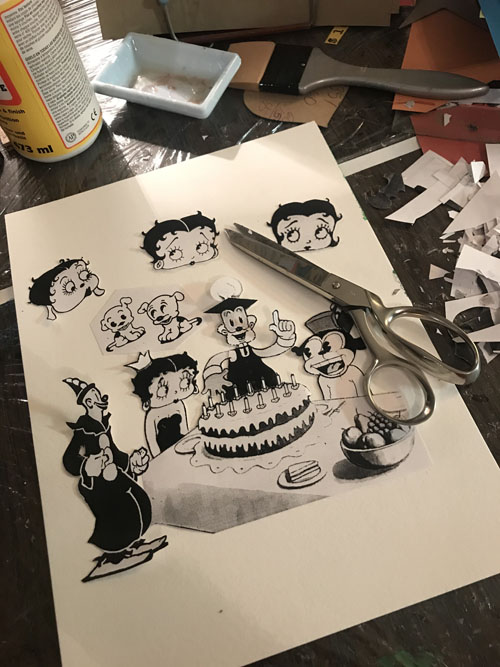
2. Next – lay them out on top of some really cool back drops – vintage wall paper or gift wrap is best
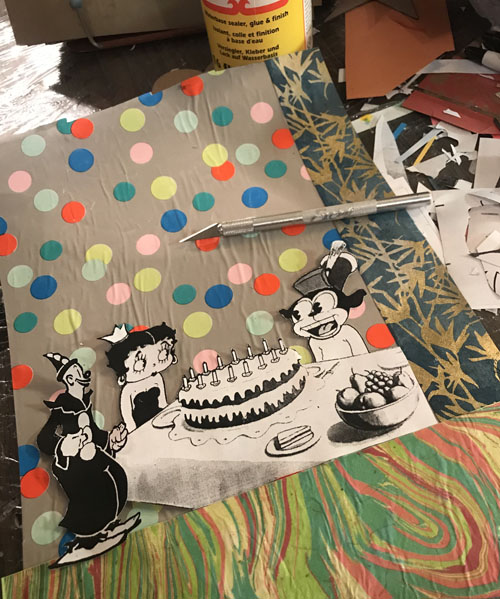
3. Now, add more pictures!
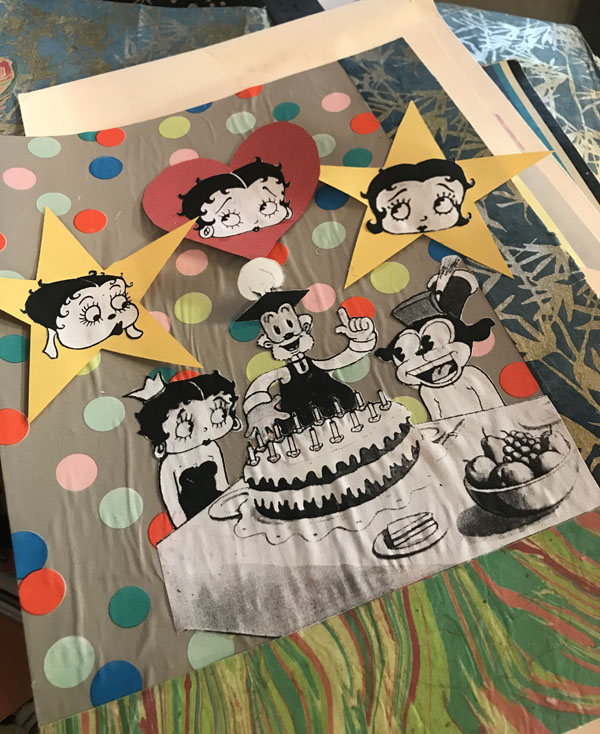
4. Then, rubber stamp your text on colored paper
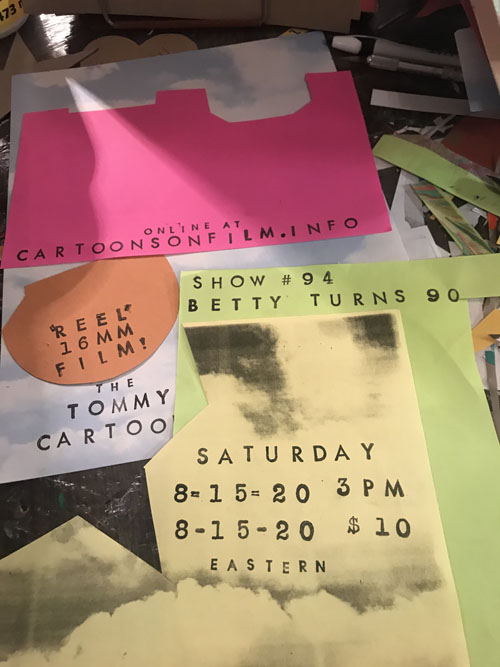
5. Put It All Together – and Voilà!
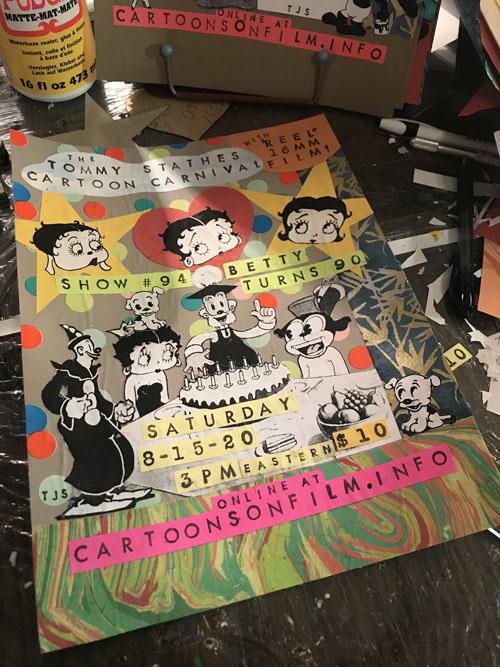
And That’s How You Do It!
Finally, in anticipation of next week’s stream, enjoy our teaser trailer:
In the meantime, what are some of your favorite Betty appearances? And where would you like to see Betty and the Fleischer franchises go throughout the rest of this new century?


 Tommy Stathes is an animation historian specializing in silent era cartoons. He resides in New York and frequently holds public screenings throughout the city. You can read more about his work, his collection and his research on his website:
Tommy Stathes is an animation historian specializing in silent era cartoons. He resides in New York and frequently holds public screenings throughout the city. You can read more about his work, his collection and his research on his website: 
















































“This is Betty’s birthday party day!”
As it happens, I celebrated Betty’s 90th yesterday with a cartoon marathon of my own, from “Dizzy Dishes” to “Rhythm on the Reservation” and a whole lot in between: not a complete filmography by any means, but over 50 of them, by far my one-day personal best for Betty Boops. There are so many great ones, but if I had to pick the best, it would be “Red Hot Mamma”. For design, music, animation, surrealism, laughs, and sex appeal — everything about it is absolute top quality. A masterpiece.
The only one I really don’t like is “Henry, the Funniest Living American”. That glabrous freak isn’t the funniest living anything. Say what you will about Wiffle Piffle, but at least that swishy walk of his makes me laugh every time I see it.
As always, the live streaming of your Cartoon Carnival comes at an inconvenient hour in my time zone, but I’ll have to catch it later on demand if only to see that rare cartoon where Betty has her hair in pigtails! I’ve never seen that one — a Screen Song, perhaps?
Happy birthday, Betty — and a happy Boop-Day to all next Saturday!
Hey Tommy,
Umm… I Saw The Trailler And At 0:27 There Was A Cartoon That I Have Not Seen. Was That From a Rare Cartoon released On December 13th 1930?
Another thumbs-down vote for Henry. The comic strip was never funny, and not even Fleischer could change that. He looked creepy too, with his premature baldness, after-the-fact Popeye chin, and NO MOUTH. Until Max and Dave gave him one.
Anyway…
Have a great event, Tommy. I dig your package designs.
Best use of Henry was is an SCTV sketch – this was after Robert Altman released his Popeye movie; “now here’s a scene from his upcoming Henry movie” (with Rick Moranis as Henry).
Yeah, there were better comic strips with silent protagonists, such as “Ferd’nand” and Harry Hanan’s “Louie.”
To address your final question: I would like to see all of the Fleischer cartoons preserved, restored, and made available in new viewing formats as the technology develops, so that they will continue to entertain, inspire, and boggle the minds of future generations. But I’m not keen on the notion of making new Betty Boop cartoons. To me, Betty is a purely 1930s phenomenon, and it would be unfair to expect her to play by today’s rules. Her own history shows what can happen when people with good intentions are given the power to interfere with the creative process.
What is the name of the cartoon character in the Betty Boop series that wears a hat (that looks like a professor hat) and has a light bulb over his head?
His name is “Grampy”